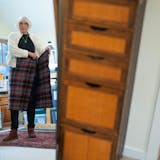Kids at Northwest Eye Clinic in Minnetonka can choose from a variety of fun, colorful eye patches to help with vision correction. That's a lot more options than Laura Olson had when she was "patching" growing up.
"I don't know if they even made these back then," Olson said about the patches decorated with trains, hearts and glitter.
Olson, 28, was born with a condition in her left eye called persistent fetal vasculature. That means her eye didn't form correctly, which can lead to chronic vision problems or, potentially, blindness.
At 1 day old, her mother brought Olson to see pediatric ophthalmologist Dr. Richard Freeman. At 6 days old, Olson had the first of six surgeries to fix a cataract.
Over the years, visits to Freeman became a weekly, then monthly, occurrence.
"It was a lot of dedication," Freeman said. "I'd see her mom every week and she'd bring her older sister with her … and so I watched [Olson] grow for years."
Freeman still keeps his eye on Olson, but she's no longer his patient. Now she works alongside her former doctor as an orthoptist.
While many people have never heard the term "orthoptics," the field is decades old. Orthoptists work with eye doctors, evaluating and treating patients with vision disorders. Programs typically require a four-year undergraduate degree, followed by two years of orthoptics study.


